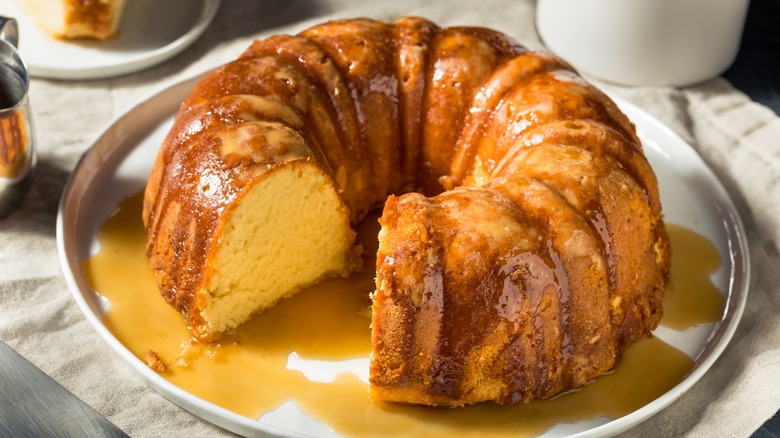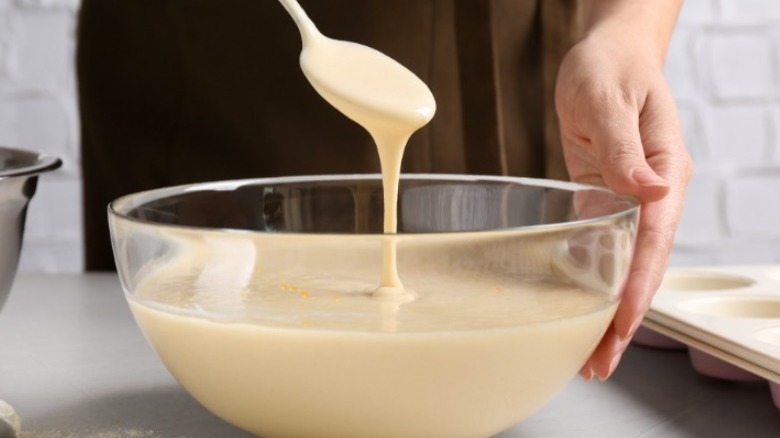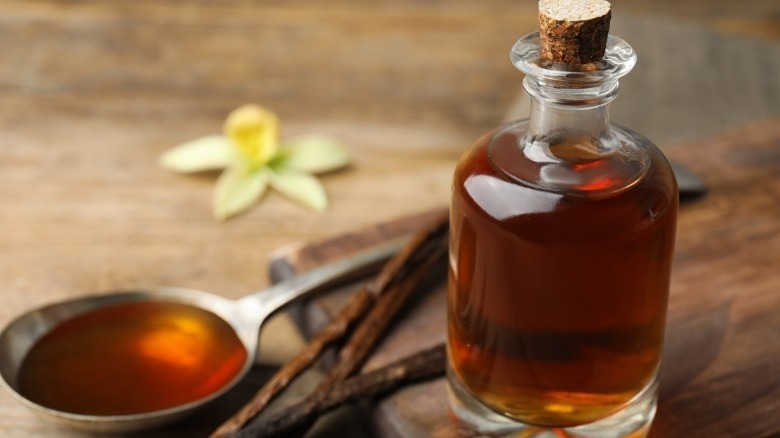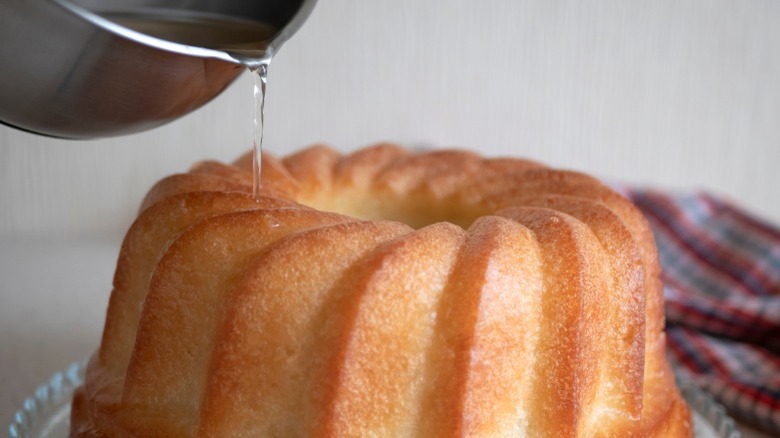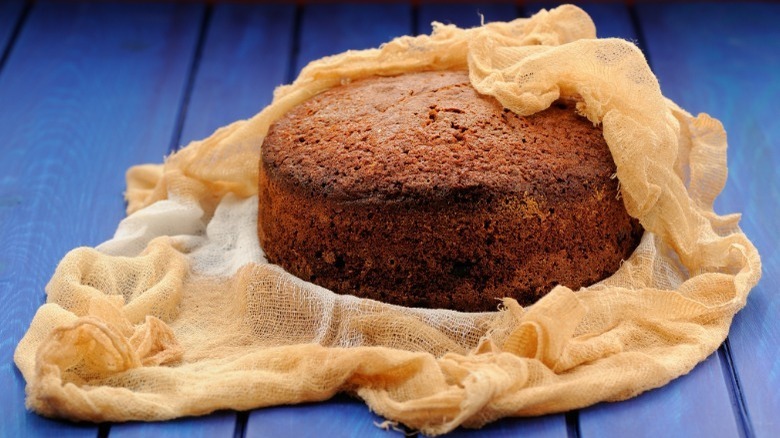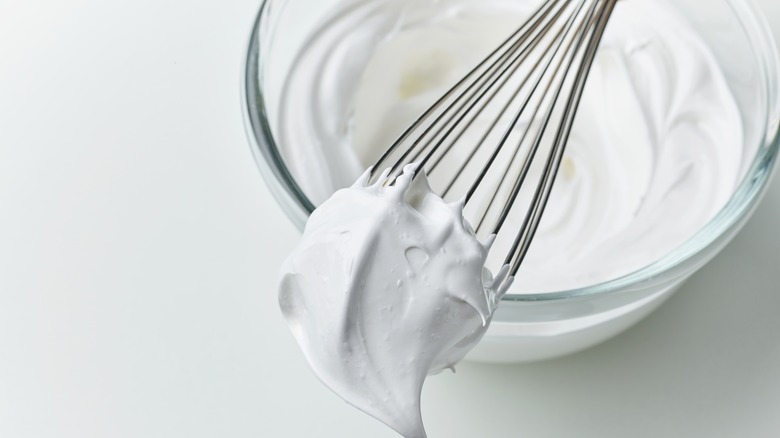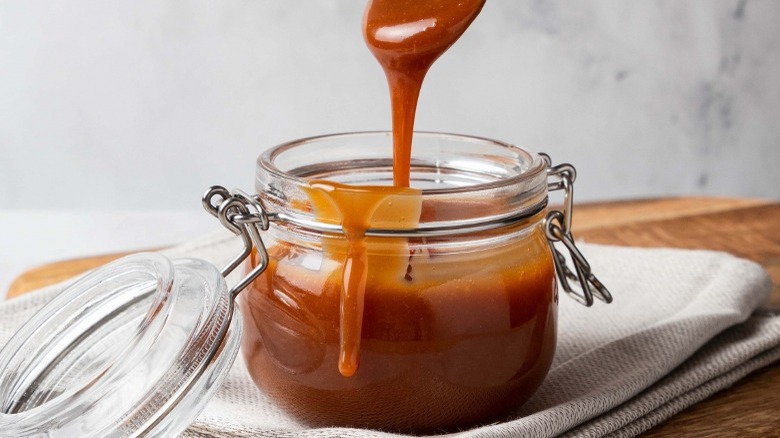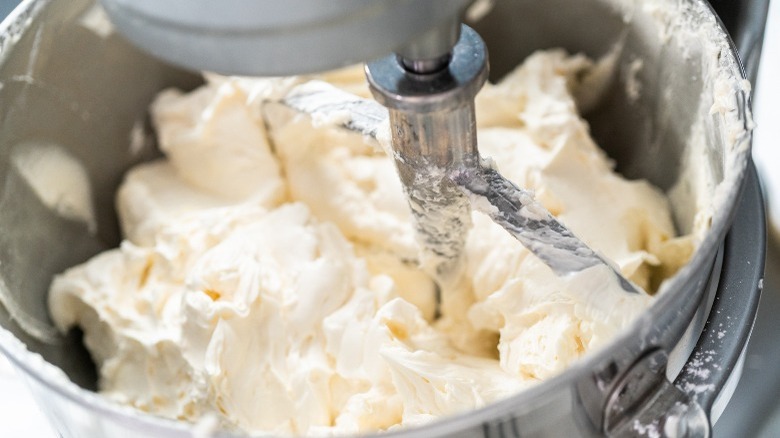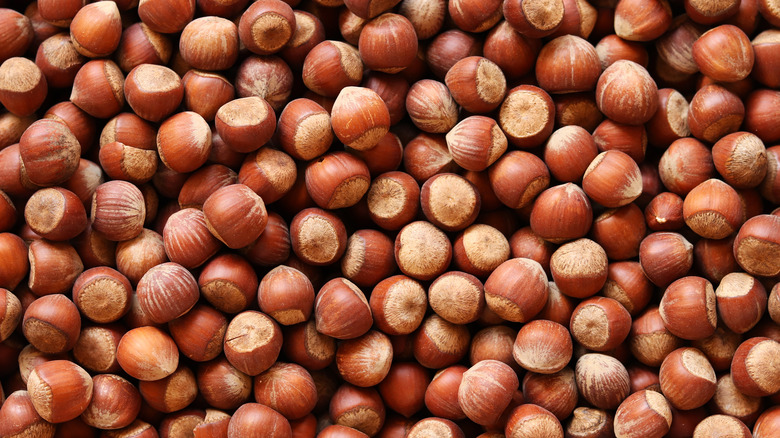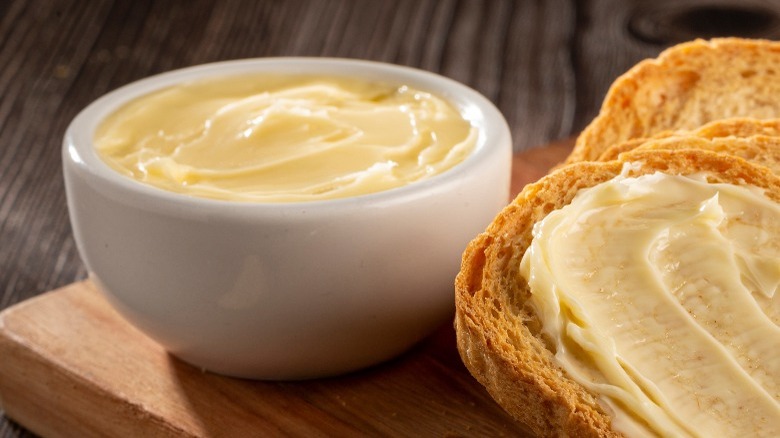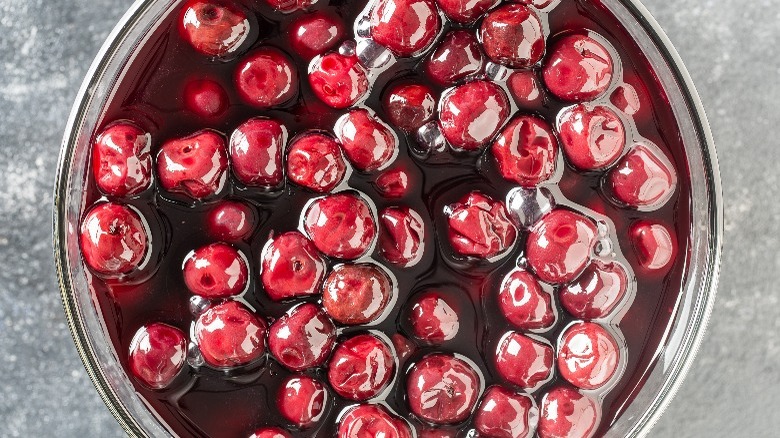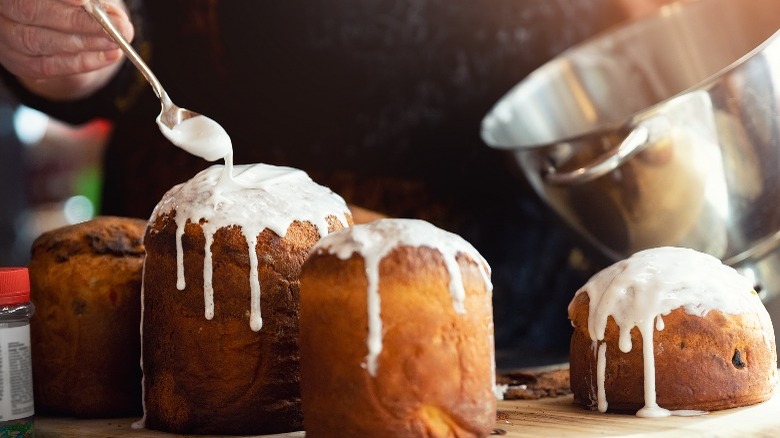11 Ways To Infuse Alcohol Into Cakes
If you're looking for new ways to amp up your pastry skills, head to your home bar for inspiration. Baking with booze improves flavor, texture, and moisture, and it's a fun way to experiment as both a mixologist and a self-proclaimed pastry artist. Whether you have a quality bourbon gleaming proudly on your top shelf or a sparkling wine that never made it to midnight this New Year's Eve, there's a recipe that will celebrate their nuanced flavors.
While it's easy to follow a recipe verbatim, messing with baked goods' ingredients (a.k.a. scientific components) can be tricky if you are new to baking. That's because baking is precise, and swapping ingredients can yield seriously wonky results. Consider baking a chemically sensitive skill.
That means whatever ingredients you use, or in whichever order you choose to mix them in, will change the final flavor, consistency, moisture, and so much more. So before you dump your favorite liquor into your cake batter, you will want to understand a few things. There are plenty of ways to infuse alcohol into your confections and cakes, and we'll give you the rundown so you can turn things from traditional to tipsy.
Add alcohol directly to the batter
Every ingredient you add plays a significant role in creating any delicious baked good, but the combination of the ingredients builds the foundation before the heat comes into play. For example, flour's primary function is to build structure in a cake, but it needs moisture from ingredients like sugar and fat to bring on the flavor and moisture and activates elements that leaven the batter. More importantly, liquids like water help provide "lift" through evaporation, resulting in a lovely airy baked cake.
But alcohol plays a different role in cake batters than other liquids like milk or water. Alcohol gives off a unique boozy flavor, which differs depending on what type you use, and evaporates quickly. While that evaporation is excellent for carrying unique flavors through the cake, you need to consider the percentage of alcohol, too. The amount of booze you add depends on the type of alcohol and the percentage of alcohol in each type. That's because alcohol will diminish some of the cake's structure. When using alcohol, add water to compensate for volume differences.
Take this classic white cake recipe, for example. It uses 1 ¼ cup of whole milk as the main liquid ingredient, while this classic pink champagne recipe uses 1 ¼ cup of champagne as the essential liquid. If you want to add hard liquor to your white cake, substitute some of the milk with alcohol. Understand that the cake's structure will differ with this substitution, but still taste lovely.
Substitute alcohol for extracts
One way to accurately add liquor to your cake batter without interfering too much with texture is by substituting alcohol in extracts. In fact, you can make your very own vanilla extract with vodka, bourbon, brandy, or rum.
You only need vanilla beans and booze to make a homemade pure vanilla extract. The best part is it costs much less to make it yourself. After splitting a vanilla bean pod down the middle and exposing those precious seeds, you plop an entire pod in a small bottle of your favorite liquor. Voilà. The only issue with making it homemade is that it won't be ready for at least 30 days, so stick it in your pantry and use what you have in the meantime. Whether you use imitation or pure extract for your cake baking, most extracts contain some amount of alcohol in them. That's why substituting alcohol for extracts is so easy and practical.
Next time you make a cake consider swapping out the extract for hard liquor. Remember to find a liquor you enjoy and one that balances well with the flavors of the cake you are already making. For example, bourbon often boasts sweet aromatic essences like honey and chocolate, so it would taste lovely in a chocolate cake. A sweet liqueur like Amaretto Disaronno will have you swooning over a marzipan or nut-filled cake.
Soak your cake with a boozy syrup
There are several tricks that professional cake bakers use to ensure they are sending off moist and flavorful cakes to their customers every time, and one of them is all about simple syrup. Once the cakes are baked in bulk, they have to cool, then get placed in the freezer. After all, you can't frost a warm or room-temperature cake.
Before a pastry chef or professional baker grabs the tub of homemade buttercream, they will run to their scratch stash of simple syrup instead. Ever so gently, simple syrup is brushed over every carved layer of cake to help provide extra moisture and flavor. Next time you think you have baked your cake too much or left it out too long to cool (resulting in dried-out layers), consider crafting a quick, simple syrup. Make a simple syrup by combining equal parts water and sugar. From there, you can consider adding your touch of flavor to the syrup to help booze up those baked layers.
Feed your cake using cheesecloth
To make a fruit cake, ingredients like raisins, apricots, and figs are soaked in the liquor of choice. Dry and wet ingredients are combined separately and then come together before the macerated fruit is folded in. From there, the oven takes care of the actual baking. However, your fruitcake is far from being finished, as it needs some help from cheesecloth and more booze to age the cake.
Like a fine wine or a quality cheese, you'll find nuanced flavors emerge over time, giving these ingredients a quality you won't get before the aging process. Fruitcake is similar in that you want it to age gracefully and develop deep flavors over time. This can be done by wrapping your cooled loaves with liquor-soaked cheesecloth, then placing them in a sealed food-safe container. Over about five or six weeks, you'll want to drizzle small amounts of alcohol about once a week. This process is called "feeding" your fruitcake and will help it retain moisture.
Slightly sweet and subtly spicy spirits like cognac, rum, or brandy suit the cake and spiked fruit well. If you are a fruitcake cynic but have never tried a homemade version, consider this your year. Just keep in mind that because you are soaking your cake with liquor and not allowing heat to destroy the properties and "bake it out," you might find a few too many slices might give you a buzz. Eat with caution.
Whip up a liqueur whipped cream
Oh, how we love the dreaminess of whipped cream. Those little clouds of heaven taste lovely dolloped over puddings, ice cream sundaes, and just about anything sweet. Making a quick batch is as simple as beating the liquid until it reaches firm peaks, but there are plenty of ways to amp up the topping.
Powdered sugar sweetens it just right, while extracts and other ingredients help bring out gentle nuances for your tastebuds to interpret joyfully. But beyond the classic sweeteners and add-ins, whipped cream also takes to new flavors well. A sprinkle of cinnamon brings a warm touch, maple syrup delivers a sweet earthy flare, and a small dab of raspberry jam will get a juicy fruit sensation and add color to the creamed topping. Even alcohol can help bring out the best in whipped cream, as long as you don't overdo it.
These mudslide cupcakes with an Irish cream liqueur-infused whipped cream are an excellent example of how you can bring on the booze. The key is keeping your alcohol additions minimal to ensure you still reach soft peaks. One to 2 tablespoons of liqueur are just enough. Crème de menthe, Kahlua, Frangelico, Grand Marnier, Chambord, and Amaretto are all tasty liqueur options to try depending on the overall flavor theme of your cake.
Warm up a caramel bourbon sauce
Bourbon, which tends to be a bit sweeter than most other types of whiskey, offers an abundance of complex flavors depending on aging, the type of barrel used, and the amount of charring inside the barrel. The new oak barrels that bourbon must age in provide a developed flavor like sweet caramel or vanilla. Some bourbons even boast warm spicy hints of flavor.
Whether your home bar's top shelf is sporting a bottle of Makers Mark or Knob Creek, we urge you to take it to your kitchen for dessert. And while a bourbon neat (or on the rocks) for dessert alone hits the spot after a savory meal, we recommend taking it one step further. By combining sugar, heavy cream, maple syrup, butter, and a generous dose of bourbon, you'll have a tasty spiked sauce that'll top just about anything sweet. Ice cream, apple pie, and bundt cakes will all welcome a dreamy drizzle, but you'll also appreciate adding to milkshakes, cupcakes, and pound cakes.
One of our favorite ways to enjoy a whiskey caramel sauce is by swirling it into a cheesecake. You'll make a quick graham cracker crust, then your whiskey caramel and cheesecake filling, and finish the dessert with a crafted swirl that everyone will enjoy before devouring.
Spike your frosting with alcohol
If you enjoy spiking your batters with liquor, beer, and wine but want to add a more robust flavor to your cakes, then we say add it to the frosting, too. Whether someone is biting into a cupcake or a fresh slice of cake, their tastebuds will likely interact with the frosting before anything else, so adding a touch (or two) of booze will bring on the punchy flavors.
In the warm spring and summer seasons, try making these Lemon Shandy cupcakes, which boast lots of lip-puckering tartness and a refreshing touch of Hefeweizen beer. A lemon shandy is a beer cocktail made by combining lemonade and wheat beer. Now you can make it in cupcake form. Um, yes, please!
If you consider yourself more of a wine person, perhaps these rosé wine raspberry cupcakes are a little more your style. It is as simple as combining a box of Betty Crocker white cake mix with water, rosé, oil, and eggs before filling each mini cake with a seedless raspberry jam. The wine frosting and fresh raspberry garnish finish these little guys off. Wine cupcakes are great for small celebrations like bridal showers, baby showers, or anniversary parties. They look lovely and taste delicious; anyone who loves a little buzz will also appreciate them.
Soak nuts in alcohol before adding them in
Macerating (or soaking) nuts in alcohol before adding them to the batter is another excellent way to chew your booze. This will work great for any favorite cake recipe that already calls for pecans, walnuts, pistachios, or any other type of nut.
For example, if you're looking for a new way to bring a big flavor to your carrot cake, consider soaking your chopped nuts in bourbon, amaretto, or Frangelico before adding them to the batter. Just be sure to remove the nuts from the liquor before adding them to your batter. For an additional punch, remember you can substitute your extract with some of that liquor, too.
Kentucky Bourbon balls are another fun confection you can try to make with the help of some bourbon-spiked pecans. According to the recipe, you'll macerate the chopped nuts for a few hours before adding them to the mix. Like most recommended recipes, you'll want to reserve these tasty treats for adults only because they won't see any oven time.
Make a boozy butter
We love butter for its ability to add a depth of richness with just one smear over your favorite snack or meal. Because butter carries other flavors so well, it works in a plethora of dishes, both savory and sweet.
Believe it or not, there's a hidden culinary gem of secret we want you to know about, and it's all about adding booze to your butter. The overall results will vary depending on the type of liquor you use, and there are plenty of options to try.
Sweet desserts like cake will appreciate the addition of spiked compound butter made with sweeter-sided liquors like bourbon, rum, or cognac. Just remember that adding spiked butter to your cake batter means it'll cook out while spending time in the oven. However, to appreciate the nuanced flavor notes of a well-crafted boozy butter, consider trying this instead: After making your boozy butter, consider schmearing it over a warm slice of pound cake, coffee cake, or even an airy piece of angel food cake.
Macerate your fruit in a booze bath
Just like you can soak nuts in alcohol before adding them to a cake batter, you are welcome to macerate the fruit in the same respect. Some of the most famous cakes are known for doing exactly that. Fruit cake, for example, is made with an abundance of fruit, nuts, and lots of alcohol.
The dense holiday cake can take weeks to prepare if you plan on feeding it booze every few days, but there are a few other essential tips you won't want to skip if you wish for superior results. You should never skip soaking your fruit for fruitcake because if they are added in while dry, they will soak up all the moisture added to your batter. That can't happen if they are already engulfed with liquor, so be sure to give them a good day or two in a rum or brandy bath.
You can even give a makeover to your simple summer shortcake by macerating the strawberries in a bit of red wine and granulated sugar. Otherwise, a bowl of sweet bourbon-soaked berries or peaches spooned over a slice of angel food cake or pound cake, topped with a dollop of boozy whipped cream, will surely give your friends something to giggle about.
Top your cake with a boozy glaze
Similar to topping your cakes with sweet syrups and fluffy buttercream frostings, a few cakes will happily take on the addition of a drizzly glaze. In fact, the beloved Martha Stewart herself enjoys serving her friends a lemony fresh pound cake topped with a buttery Armagnac glaze.
Armagnac, which is similar to cognac, offers a unique flavor that combines beautifully with sugar and butter to create an intoxicatingly delicious drizzle on cakes through the months of spring and summer. Imagine enjoying that after a grilled steak and shrimp dinner on the barbecue. Mini plum cakes topped with a rum glaze are lovely throughout the colder months. But the best part? You can make these little darlings with the help of your favorite yellow cake mix. Don't forget to reserve the additional sauce, which you'll finish your warm cakes with right before indulging.
Remember that most glazes and icings are made with powdered sugar, milk (or water), and vanilla extract. If you are looking for an icing that packs a bit more punch, be sure to substitute the extract for bourbon, rum, or a favorite liqueur. From there, you can enjoy that glossy sheen of a glaze over any cake or confection you fancy.
Static Media owns and operates Tasting Table, The Daily Meal, and Mashed.
